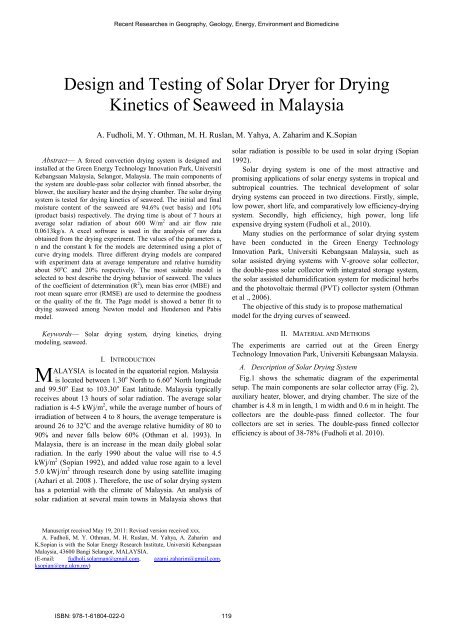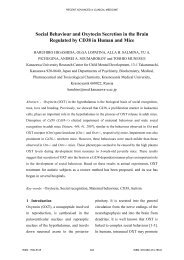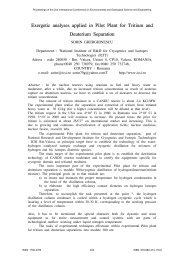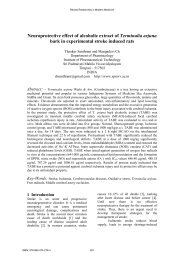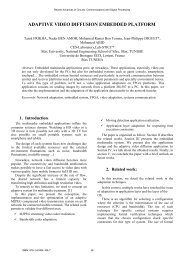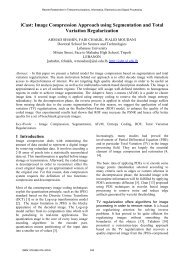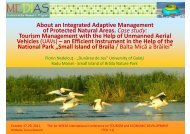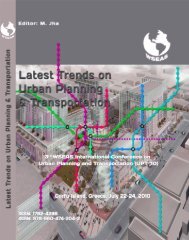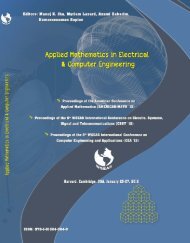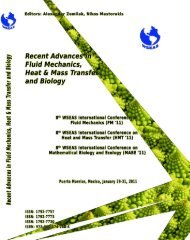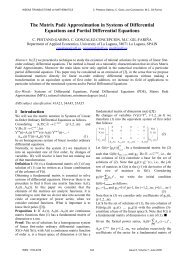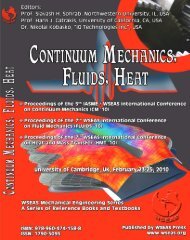Design and Testing of Solar Dryer for Drying Kinetics of ... - Wseas.us
Design and Testing of Solar Dryer for Drying Kinetics of ... - Wseas.us
Design and Testing of Solar Dryer for Drying Kinetics of ... - Wseas.us
You also want an ePaper? Increase the reach of your titles
YUMPU automatically turns print PDFs into web optimized ePapers that Google loves.
Abstract— A <strong>for</strong>ced convection drying system is designed <strong>and</strong><br />
installed at the Green Energy Technology Innovation Park, Universiti<br />
Kebangsaan Malaysia, Selangor, Malaysia. The main components <strong>of</strong><br />
the system are double-pass solar collector with finned absorber, the<br />
blower, the auxiliary heater <strong>and</strong> the drying chamber. The solar drying<br />
system is tested <strong>for</strong> drying kinetics <strong>of</strong> seaweed. The initial <strong>and</strong> final<br />
moisture content <strong>of</strong> the seaweed are 94.6% (wet basis) <strong>and</strong> 10%<br />
(product basis) respectively. The drying time is about <strong>of</strong> 7 hours at<br />
average solar radiation <strong>of</strong> about 600 W/m 2 <strong>and</strong> air flow rate<br />
0.0613kg/s. A excel s<strong>of</strong>tware is <strong>us</strong>ed in the analysis <strong>of</strong> raw data<br />
obtained from the drying experiment. The values <strong>of</strong> the parameters a,<br />
n <strong>and</strong> the constant k <strong>for</strong> the models are determined <strong>us</strong>ing a plot <strong>of</strong><br />
curve drying models. Three different drying models are compared<br />
with experiment data at average temperature <strong>and</strong> relative humidity<br />
about 50 o C <strong>and</strong> 20% respectively. The most suitable model is<br />
selected to best describe the drying behavior <strong>of</strong> seaweed. The values<br />
<strong>of</strong> the coefficient <strong>of</strong> determination (R 2 ), mean bias error (MBE) <strong>and</strong><br />
root mean square error (RMSE) are <strong>us</strong>ed to determine the goodness<br />
or the quality <strong>of</strong> the fit. The Page model is showed a better fit to<br />
drying seaweed among Newton model <strong>and</strong> Henderson <strong>and</strong> Pabis<br />
model.<br />
Keywords— <strong>Solar</strong> drying system, drying kinetics, drying<br />
modeling, seaweed.<br />
M<br />
Recent Researches in Geography, Geology, Energy, Environment <strong>and</strong> Biomedicine<br />
<strong>Design</strong> <strong>and</strong> <strong>Testing</strong> <strong>of</strong> <strong>Solar</strong> <strong>Dryer</strong> <strong>for</strong> <strong>Drying</strong><br />
<strong>Kinetics</strong> <strong>of</strong> Seaweed in Malaysia<br />
A. Fudholi, M. Y. Othman, M. H. R<strong>us</strong>lan, M. Yahya, A. Zaharim <strong>and</strong> K.Sopian<br />
I. INTRODUCTION<br />
ALAYSIA is located in the equatorial region. Malaysia<br />
is located between 1.30 o North to 6.60 o North longitude<br />
<strong>and</strong> 99.50 o East to 103.30 o East latitude. Malaysia typically<br />
receives about 13 hours <strong>of</strong> solar radiation. The average solar<br />
radiation is 4-5 kWj/m 2 , while the average number <strong>of</strong> hours <strong>of</strong><br />
irradiation <strong>of</strong> between 4 to 8 hours, the average temperature is<br />
around 26 to 32 o C <strong>and</strong> the average relative humidity <strong>of</strong> 80 to<br />
90% <strong>and</strong> never falls below 60% (Othman et al. 1993). In<br />
Malaysia, there is an increase in the mean daily global solar<br />
radiation. In the early 1990 about the value will rise to 4.5<br />
kWj/m 2 (Sopian 1992), <strong>and</strong> added value rose again to a level<br />
5.0 kWj/m 2 through research done by <strong>us</strong>ing satellite imaging<br />
(Azhari et al. 2008 ). There<strong>for</strong>e, the <strong>us</strong>e <strong>of</strong> solar drying system<br />
has a potential with the climate <strong>of</strong> Malaysia. An analysis <strong>of</strong><br />
solar radiation at several main towns in Malaysia shows that<br />
Man<strong>us</strong>cript received May 19, 2011: Revised version received xxx.<br />
A. Fudholi, M. Y. Othman, M. H. R<strong>us</strong>lan, M. Yahya, A. Zaharim <strong>and</strong><br />
K.Sopian is with the <strong>Solar</strong> Energy Research Institute, Universiti Kebangsaan<br />
Malaysia, 43600 Bangi Selangor, MALAYSIA.<br />
(E-mail: fudholi.solarman@gmail.com, azami.zaharim@gmail.com,<br />
ksopian@eng.ukm.my)<br />
ISBN: 978-1-61804-022-0 119<br />
solar radiation is possible to be <strong>us</strong>ed in solar drying (Sopian<br />
1992).<br />
<strong>Solar</strong> drying system is one <strong>of</strong> the most attractive <strong>and</strong><br />
promising applications <strong>of</strong> solar energy systems in tropical <strong>and</strong><br />
subtropical countries. The technical development <strong>of</strong> solar<br />
drying systems can proceed in two directions. Firstly, simple,<br />
low power, short life, <strong>and</strong> comparatively low efficiency-drying<br />
system. Secondly, high efficiency, high power, long life<br />
expensive drying system (Fudholi et al., 2010).<br />
Many studies on the per<strong>for</strong>mance <strong>of</strong> solar drying system<br />
have been conducted in the Green Energy Technology<br />
Innovation Park, Universiti Kebangsaan Malaysia, such as<br />
solar assisted drying systems with V-groove solar collector,<br />
the double-pass solar collector with integrated storage system,<br />
the solar assisted dehumidification system <strong>for</strong> medicinal herbs<br />
<strong>and</strong> the photovoltaic thermal (PVT) collector system (Othman<br />
et al ., 2006).<br />
The objective <strong>of</strong> this study is to propose mathematical<br />
model <strong>for</strong> the drying curves <strong>of</strong> seaweed.<br />
II. MATERIAL AND METHODS<br />
The experiments are carried out at the Green Energy<br />
Technology Innovation Park, Universiti Kebangsaan Malaysia.<br />
A. Description <strong>of</strong> <strong>Solar</strong> <strong>Drying</strong> System<br />
Fig.1 shows the schematic diagram <strong>of</strong> the experimental<br />
setup. The main components are solar collector array (Fig. 2),<br />
auxiliary heater, blower, <strong>and</strong> drying chamber. The size <strong>of</strong> the<br />
chamber is 4.8 m in length, 1 m width <strong>and</strong> 0.6 m in height. The<br />
collectors are the double-pass finned collector. The four<br />
collectors are set in series. The double-pass finned collector<br />
efficiency is about <strong>of</strong> 38-78% (Fudholi et al. 2010).
Air inlet<br />
1.5 m<br />
1.5 m<br />
Recent Researches in Geography, Geology, Energy, Environment <strong>and</strong> Biomedicine<br />
0.6 m<br />
Auxiliary<br />
heater<br />
The collector width <strong>and</strong> length were 1.2 m <strong>and</strong> 4.8 m<br />
respectively. The solar collector array consists <strong>of</strong> 4 solar<br />
collectors. The upper channel depth is 3.5 cm <strong>and</strong> the lower<br />
depth is 7 cm. The bottom <strong>and</strong> sides <strong>of</strong> the collector have been<br />
insulated with 2.5cm thick fiberglass to minimize heat losses.<br />
Table 1 shows key parameters <strong>of</strong> the solar drying system.<br />
Fig. 3 shows the cross section <strong>of</strong> the collector with the<br />
aluminium plate fins. The collector consists <strong>of</strong> the glass cover,<br />
the insulated container <strong>and</strong> the black painted aluminium<br />
absorber. The size <strong>of</strong> the collector is 1.2 m wide <strong>and</strong> 4.8 cm<br />
long. In this type <strong>of</strong> collector, the air initially enters through<br />
the first channel <strong>for</strong>med by the glass covering the absorber<br />
plate <strong>and</strong> then through the second channel <strong>for</strong>med by the back<br />
plate <strong>and</strong> the finned absorber plate.<br />
Table 1. Key parameters <strong>of</strong> the solar drying system<br />
Parameters Unit Value<br />
Collector area m 2 11.52<br />
<strong>Drying</strong> chamber area m 2 4.8<br />
Blower<br />
Capacity <strong>of</strong> dryer kg 150-200<br />
Mass flow rate kg/s 0.05-0.13<br />
Average drying air<br />
temperature<br />
o<br />
C 40-65<br />
4.8 m<br />
0.2 m<br />
Fig. 1. Schematic diagram <strong>of</strong> solar drying system<br />
ISBN: 978-1-61804-022-0 120<br />
15 o<br />
Double-pass solar<br />
collector with finned<br />
absorber<br />
1 m<br />
<strong>Drying</strong> chamber<br />
0.3 m<br />
Upper<br />
air flow<br />
Lower<br />
air flow<br />
Inlet Inlet<br />
Outlet air<br />
Fig. 2. The collector arrangement <strong>for</strong> the solar drying system<br />
Glass cover<br />
Air inlet<br />
Air outlet<br />
Insulation<br />
0.6 m<br />
0.4<br />
0.7 m<br />
(a)<br />
Absorber plate<br />
Fins<br />
0.1 m<br />
10<br />
20<br />
6 cm<br />
(b)<br />
Fig. 3. (a) The schematic <strong>of</strong> a double-pass solar collector with<br />
fins absorber in the second channel <strong>and</strong> (b) top view <strong>of</strong> the<br />
staggered finned absorber.
A. Method<br />
Experiment done begins at 08:00 am that day at 06:00 pm,<br />
which begins when the data was taken from 09:00 am to 05:00<br />
pm. The data measured are air temperature (ambient<br />
temperature, air temperature inlet <strong>and</strong> outlet <strong>of</strong> the collector),<br />
radiation intensity <strong>and</strong> air velocity, also measured the air<br />
temperature be<strong>for</strong>e it enters the dryer chamber, the temperature<br />
inside the dryer chamber, the temperature <strong>of</strong> the air out <strong>of</strong> the<br />
dryer chamber <strong>and</strong> wet bulb temperature <strong>and</strong> dry bulb<br />
temperature <strong>of</strong> the air out <strong>of</strong> the dryer chamber. Air<br />
temperature was measured by T-type thermocouple is then<br />
recorded in a data acquisition system. The intensity <strong>of</strong> solar<br />
radiation measured by pyranometer <strong>and</strong> measurement data<br />
recorded in a computer.<br />
B. Data Analysis<br />
The thermal efficiency <strong>of</strong> a solar collector is the ratio <strong>of</strong><br />
<strong>us</strong>eful heat gain to the solar radiation incident on the plane <strong>of</strong><br />
the collector. It is defined as (Fudholi et al. 2011)<br />
( T − T )<br />
mC o i<br />
η c =<br />
x100%<br />
(1)<br />
A I<br />
c<br />
where,<br />
m = mass flow rate (kg/s)<br />
C = specific heat <strong>of</strong> air (J kg -1 o C -1 )<br />
Ac = collector area (m 2 )<br />
Ti = inlet air temperature ( o C)<br />
To = outlet air temperature ( o C)<br />
I = solar radiation intensity (W/m 2 )<br />
Recent Researches in Geography, Geology, Energy, Environment <strong>and</strong> Biomedicine<br />
To determine the kinetics <strong>of</strong> drying seaweed, drying model<br />
is <strong>us</strong>ed. Table 2 shows there are some drying models.<br />
Table 2. Several models <strong>of</strong> drying (Aktas et al. 2009; Ibrahim<br />
et al. 2009)<br />
No. Model name Model<br />
1 Newton MR = exp(-kt)<br />
2 Page MR = exp(-kt n )<br />
3 Modified Page MR =exp(-(kt) n )<br />
4 Henderson <strong>and</strong> Pabis MR = a exp(-kt)<br />
The moisture ratio (MR) can be calculated as (Ibrahim et al.<br />
2009)<br />
M − M e<br />
MR =<br />
(2)<br />
M − M<br />
0<br />
where,<br />
Me = Equilibrium moisture content<br />
Mo = Initial moisture content<br />
The moisture content <strong>of</strong> materials (M) can be calculated by<br />
two methods on the basis <strong>of</strong> either wet or dry basis <strong>us</strong>ing the<br />
following equation. The moisture content wet basis<br />
e<br />
ISBN: 978-1-61804-022-0 121<br />
( t)<br />
w − d<br />
M = x100%<br />
(3)<br />
w<br />
The moisture content dry basis (Dissa et al. 2009)<br />
w(<br />
t)<br />
− d<br />
X = (4)<br />
d<br />
where,<br />
w(t) = mass <strong>of</strong> wet materials at instant t<br />
d = mass <strong>of</strong> dry materials<br />
The value <strong>of</strong> initial moisture seaweeds need to know be<strong>for</strong>e<br />
drying done in the solar drying system. The study <strong>of</strong> seaweed<br />
drying <strong>us</strong>ing Low Temperature Test Chamber <strong>and</strong> Humidity in<br />
the <strong>Solar</strong> Energy Laboratory, Faculty <strong>of</strong> Science <strong>and</strong><br />
Technology, Universiti Kebangsaan Malaysia, instead <strong>of</strong><br />
seaweed drying tests found it had an initial moisture content <strong>of</strong><br />
94.6%.<br />
The values <strong>of</strong> the coefficient <strong>of</strong> determination (R 2 ), mean<br />
bias error (MBE) <strong>and</strong> root mean square error (RMSE) are <strong>us</strong>ed<br />
to determine the quality <strong>of</strong> the drying model. The highest R 2<br />
values <strong>and</strong> the values <strong>of</strong> MBE <strong>and</strong> the lowest RMSE are<br />
selected to estimate the drying curve is the best (Ibrahim et al.<br />
2009).<br />
N 1 2<br />
MBE = ( MR pre,<br />
i − MRexp,<br />
i ) (5)<br />
N<br />
∑<br />
i=<br />
1<br />
1<br />
N<br />
2<br />
⎡ 1<br />
2 ⎤<br />
= ⎢ ∑ ( pre,<br />
i − exp, i ) ⎥<br />
i=<br />
1<br />
MR<br />
MR<br />
RMSE (6)<br />
N<br />
⎣<br />
III. RESULTS AND DISCUSSION<br />
Experiments carried out starting at 08:00 am today so at<br />
6:00 pm, the time data were taken beginning at 09:00 am till<br />
05:00 pm. Fig. 4 shows experimental results <strong>of</strong> drying seaweed<br />
which in sunny weather, obtained dryer chamber temperature<br />
range around 30°C
<strong>Solar</strong> radiation (W/m 2 )<br />
1000<br />
900<br />
800<br />
700<br />
600<br />
500<br />
400<br />
300<br />
200<br />
100<br />
<strong>Solar</strong> radiation<br />
Efficiency<br />
0<br />
0<br />
9.00 10.00 11.00 12.00 13.00 14.00 15.00 16.00 17.00 18.00<br />
Time <strong>of</strong> day (h)<br />
Fig. 5. <strong>Solar</strong> radiation <strong>and</strong> efficiency <strong>of</strong> collector at mass flow<br />
rate 0.0613 kg/s<br />
<strong>Drying</strong> <strong>of</strong> seaweed in the Green Energy Technology<br />
Innovation Park <strong>us</strong>ing a solar drying system <strong>us</strong>ing double-pass<br />
solar collector with finned absorber takes 7 hours to reduce the<br />
initial moisture content <strong>of</strong> 94.6% to 8.33% equivalent to 120<br />
grams to 11 grams. <strong>Drying</strong> process on the average solar<br />
radiation about 600W/m 2 <strong>and</strong> drying air flow rate 0.0613kg/s.<br />
Change in mass was recorded every 15 minutes. Fig. 6 shows<br />
the change in mass with time, the mass <strong>of</strong> seaweed was found<br />
to decline with time. Fig. 7 shows decreased moisture content<br />
wet basis <strong>of</strong> drying time.<br />
Weight (g)<br />
Moisture content, wb (%)<br />
140<br />
120<br />
100<br />
80<br />
60<br />
40<br />
20<br />
0<br />
0 1 2 3 4 5 6 7 8 9<br />
100<br />
90<br />
80<br />
70<br />
60<br />
50<br />
40<br />
30<br />
20<br />
10<br />
Recent Researches in Geography, Geology, Energy, Environment <strong>and</strong> Biomedicine<br />
<strong>Drying</strong> time (h)<br />
Fig. 6. Weight variation with drying time<br />
0<br />
0 1 2 3 4 5 6 7 8 9<br />
<strong>Drying</strong> time (h)<br />
Fig.7. Moisture content variation with drying time<br />
Fig. 8 to Fig. 10 shows kinetic curves <strong>of</strong> drying seaweed at<br />
50 o C <strong>and</strong> relative humidity <strong>of</strong> 20%. It consists <strong>of</strong> three curves<br />
<strong>of</strong> the drying curve, the drying rate curve <strong>and</strong> the characteristic<br />
drying curve. <strong>Drying</strong> curve shows the pr<strong>of</strong>ile change in<br />
moisture content (X) vers<strong>us</strong> drying time (t). <strong>Drying</strong> rate curve<br />
shows the drying rate pr<strong>of</strong>ile (dX/dt) vers<strong>us</strong> drying time (t).<br />
ISBN: 978-1-61804-022-0 122<br />
50<br />
45<br />
40<br />
35<br />
30<br />
25<br />
20<br />
15<br />
10<br />
5<br />
Collector efficiency (%)<br />
<strong>Drying</strong> characteristic curves showed that the drying rate pr<strong>of</strong>ile<br />
(dX/dt) vers<strong>us</strong> moisture content dry basis (X).<br />
Moisture content, db (g/g)<br />
20<br />
18<br />
16<br />
14<br />
12<br />
10<br />
8<br />
6<br />
4<br />
2<br />
0<br />
0 1 2 3 4 5 6 7 8 9<br />
<strong>Drying</strong> time (h)<br />
Fig. 8. <strong>Drying</strong> curve: dry basis moisture content vers<strong>us</strong> drying<br />
time<br />
<strong>Drying</strong> rate, dX/dt, (g/g)/h<br />
10<br />
9<br />
8<br />
7<br />
6<br />
5<br />
4<br />
3<br />
2<br />
1<br />
0<br />
0.25 1.25 2.25 3.25 4.25 5.25 6.25 7.25<br />
<strong>Drying</strong> time (h)<br />
Fig. 9. <strong>Drying</strong> rate curves: dry basis moisture content vers<strong>us</strong><br />
drying time<br />
<strong>Drying</strong> rate, dX/dt, (g/g)/h<br />
10<br />
9<br />
8<br />
7<br />
6<br />
5<br />
4<br />
3<br />
2<br />
1<br />
0<br />
0 1 2 3 4 5 6 7 8 9 10<br />
Moisture content, db, (g/g)<br />
Fig. 10. <strong>Drying</strong> characteristic curves: a dry basis moisture<br />
content vers<strong>us</strong> drying time<br />
Fitting some <strong>of</strong> the drying model has been done with the<br />
experimental data <strong>of</strong> drying seaweed solar dryer system at an<br />
average temperature <strong>of</strong> 50°C chamber, <strong>and</strong> the average relative<br />
humidity 20%. <strong>Drying</strong> models are fitted with the experimental<br />
data <strong>of</strong> drying is the drying <strong>of</strong> the Newton model, Page model<br />
drying, <strong>and</strong> drying model <strong>and</strong> Pabis Henderson. <strong>Drying</strong><br />
experimental data fitted the model <strong>of</strong> drying in the <strong>for</strong>m <strong>of</strong><br />
changes in moisture content vers<strong>us</strong> drying time. In this drying<br />
models, changes in moisture content vers<strong>us</strong> time calculated<br />
<strong>us</strong>ing Excel s<strong>of</strong>tware.<br />
Table 3 shows the result matched the drying models with<br />
experimental data <strong>of</strong> drying. From Table 1 showed a constant<br />
drying <strong>and</strong> accuracy <strong>of</strong> fitting each model <strong>of</strong> drying. R 2 is the<br />
highest <strong>and</strong> the MBE <strong>and</strong> the lowest RMSE is selected to<br />
estimate the drying curve is the best (Ibrahim et al. 2009).<br />
Page equation can also be written to the equation:
( ln MR) = ln k nln<br />
t<br />
ln − +<br />
(7)<br />
Equation 7 is the relationship ln (-ln MR) vers<strong>us</strong> t, is the<br />
curve <strong>of</strong> the logarithmic equation, as sketched in Figure 12.<br />
Henderson <strong>and</strong> Pabis equation can also be written by equation<br />
ln MR = −kt<br />
+ ln a<br />
(8)<br />
From equation 8, a plot <strong>of</strong> ln MR vers<strong>us</strong> drying time gives a<br />
straight line with intercept = ln a, <strong>and</strong> slope = k. Graf MR<br />
vers<strong>us</strong> ln t, as shown in Fig. 13, obtained the value k = 0.6289<br />
<strong>and</strong> the value <strong>of</strong> a = 0.4138<br />
MR<br />
ln(-ln MR)<br />
1.2<br />
1.0<br />
0.8<br />
0.6<br />
0.4<br />
0.2<br />
y = e -0.9941x<br />
R 2 = 0.7756<br />
0.0<br />
0 1 2 3 4 5 6 7 8 9<br />
<strong>Drying</strong> time (h)<br />
Fig. 11. Plot <strong>of</strong> MR vers<strong>us</strong> drying time (Newton’s model)<br />
1.8<br />
1.6<br />
1.4<br />
1.2<br />
1<br />
0.8<br />
0.6<br />
0.4<br />
0.2<br />
y = 0.566Ln(x) + 0.4734<br />
R 2 = 0.9673<br />
0<br />
0 1 2 3 4 5 6 7 8<br />
<strong>Drying</strong> time (h)<br />
Fig. 12. Plot <strong>of</strong> ln (-ln MR) vers<strong>us</strong> drying time (Page’s model)<br />
ln MR<br />
0<br />
0 1 2 3 4 5 6 7<br />
-1<br />
-2<br />
-3<br />
-4<br />
-5<br />
-6<br />
-7<br />
Recent Researches in Geography, Geology, Energy, Environment <strong>and</strong> Biomedicine<br />
y = -0.6289x - 0.8824<br />
R 2 = 0.9375<br />
<strong>Drying</strong> time (h)<br />
Table 2. Constant value matches some <strong>of</strong> the drying model<br />
ISBN: 978-1-61804-022-0 123<br />
Predicted<br />
Fig. 13. Plot <strong>of</strong> ln MR vers<strong>us</strong> drying time (Henderson <strong>and</strong><br />
Pabis model)<br />
1.1<br />
1<br />
0.9<br />
0.8<br />
0.7<br />
0.6<br />
0.5<br />
0.4<br />
0.3<br />
0.2<br />
0.1<br />
0<br />
(7)<br />
0 0.1 0.2 0.3 0.4 0.5 0.6 0.7 0.8 0.9 1<br />
Experimental<br />
Fig.14. Comparison <strong>of</strong> experimental MR with predicted MR<br />
from Newton model<br />
Predicted<br />
1<br />
0.9<br />
0.8<br />
0.7<br />
0.6<br />
0.5<br />
0.4<br />
0.3<br />
0.2<br />
0.1<br />
0<br />
0 0.1 0.2 0.3 0.4 0.5 0.6 0.7 0.8 0.9 1<br />
Experimental<br />
Fig.15. Comparison <strong>of</strong> experimental MR with predicted MR<br />
from Page model<br />
Predicted<br />
0.6<br />
0.5<br />
0.4<br />
0.3<br />
0.2<br />
0.1<br />
0<br />
0 0.1 0.2 0.3 0.4 0.5 0.6 0.7 0.8 0.9 1<br />
Experimental<br />
Fig.16. Comparison <strong>of</strong> experimental MR with predicted MR<br />
from Henderson <strong>and</strong> Pabis model
Recent Researches in Geography, Geology, Energy, Environment <strong>and</strong> Biomedicine<br />
Model a K n R 2 MBE RMSE<br />
Newton 0.9941 0.7756 0.0087 0.0933<br />
Page 1.6054 0.566 0.9673 0.0002 0.0139<br />
Henderson<br />
& Pabis<br />
Results are given in Table (2) shows the Page drying model<br />
has the highest value <strong>of</strong> R 2 , as well as the values <strong>of</strong> MBE <strong>and</strong><br />
RMSE is the lowest compared to Newton's model <strong>of</strong> drying<br />
<strong>and</strong> drying model <strong>and</strong> Pabis Henderson, so seaweed drying<br />
model is a model suitable drying Page. Fig. 14 to Fig. 16.<br />
shows comparison <strong>of</strong> experimental MR with predicted MR<br />
from models drying. Fig 14 shows the distribution <strong>of</strong><br />
experimental values in the vicinity <strong>of</strong> the straight line shows<br />
the expected value.<br />
I. CONCLUSIONS<br />
A solar drying system <strong>us</strong>ing double-pass solar collector with<br />
finned absorber is tested on samples <strong>of</strong> seaweed. Kinetic<br />
curves <strong>of</strong> drying <strong>of</strong> seaweed are known to <strong>us</strong>e this system.<br />
From the study, seaweed drying process <strong>us</strong>ing this system has<br />
taken over a period <strong>of</strong> 7 hours <strong>for</strong> the initial moisture content<br />
94.6% to 8.33% equivalent to 120 grams to 11 grams. When<br />
the decreasing rate period is assumed to occur only a single<br />
exponential equation, the equation is the equation <strong>of</strong> drying<br />
according to the Page model equation MR = exp (-1.6054t 0.566 )<br />
with 96.7% accuracy.<br />
REFERENCES<br />
[1] Aktas, M., I. Ceylan <strong>and</strong> S. Yilmaz. 2009. Determination <strong>of</strong> drying<br />
characteristics <strong>of</strong> apples in a heat pump <strong>and</strong> solar dryer. Desalination<br />
239: 266-275.<br />
[2] Azhari, A.W., K. Sopian, Zaharim, A., et al. 2008. <strong>Solar</strong> radiation map<br />
from satellite data <strong>for</strong> a tropical environment-case study <strong>of</strong> Malaysia,<br />
Proceedings <strong>of</strong> the 3 rd IASME/WSEAS International Conference on<br />
Energy & Environment, hlm. 528-533.<br />
[3] Dissa, A.O., J.Bathiebo, S. Kam, P.W. Savadogo, H. Desmorieux <strong>and</strong> J.<br />
Koulidiati. 2009. Modelling <strong>and</strong> experimental validation <strong>of</strong> thin layer<br />
indirect solar drying <strong>of</strong> mango slices. Renewable Energy 34: 1000-1008.<br />
[4] Fudholi, A., K. Sopian, M.H.R<strong>us</strong>lan, M.Y. Othman <strong>and</strong> M. Yahya,<br />
2011. Thermal efficiency <strong>of</strong> double pass solar collector with<br />
longitudinal fins Absorbers. American Journal <strong>of</strong> Applied Sciences 8<br />
(3): 254-260.<br />
[5] Fudholi A. Sopian K, R<strong>us</strong>lan MH, Alghoul MA, Sulaiman MY. 2010.<br />
Reviev <strong>of</strong> solar dryers <strong>for</strong> agricultural <strong>and</strong> marine products. Renewable<br />
& S<strong>us</strong>tainable Energy Review;14:1-30.<br />
ISBN: 978-1-61804-022-0 124<br />
0.4138 0.6289 0.9375 0.0120 0.1098<br />
[6] Fudholi,A., M.H. R<strong>us</strong>lan, M.Y. Othman, M. Yahya, A. Zaharim <strong>and</strong> K.<br />
Sopian, 2010. Experimental Study <strong>of</strong> the Double-Pass <strong>Solar</strong> Air<br />
Collector with Staggered Fins. Proceedings <strong>of</strong> the 9 th WSEAS<br />
International Conference on SISTEM SCIENCE <strong>and</strong> SIMULATION in<br />
ENGINEERING (ICOSSSE’10), Iwate Prefectural University, Japan,<br />
October 4-6, p. 410-414.<br />
[7] Ibrahim, M., K. Sopian <strong>and</strong> W.R.W. Daud. 2009. Study <strong>of</strong> the drying<br />
kinetics <strong>of</strong> lemon grass. American Journal 0f Applied Sciences 6 (6):<br />
1070-1075.<br />
[8] Othman, M.Y.H., K. Sopian, B. Yatim, W.R.W. Daud. 2006.<br />
Development <strong>of</strong> advanced solar assisted drying systems, Renewable<br />
Energy 31:703–709<br />
[9] Othman, M.Y.H., K. Sopian, B. Yatim, & M.N. Dalimin. 1993. Diurnal<br />
pattern <strong>for</strong> global solar radiation in tropics: a case study <strong>of</strong> Malaysia,<br />
Renewable Energy, 3(6/7):741-746.<br />
[10] Sopian, K. <strong>and</strong> Othman, M.Y. 1992. Estimate <strong>of</strong> monthly average daily<br />
solar radiation in Malaysia. Renewable Energy 2(3): 319-325.


